Content
Published:
Higher energy intensity in 2015
Energy use in the Norwegian economy grew by 2.4 per cent from 2014 to 2015. During the same period, however, production in the Norwegian economy grew by only 1.2 per cent. The energy intensity thereby increased by 1.2 per cent from 2014 to 2015.
| All energy products | Per cent change | ||||
|---|---|---|---|---|---|
| 2000 | 2014 | 2015 | 2000-2015 | 2014 - 2015 | |
| 1Except energy products used for non-energy purposes, conversion in refineries and households. | |||||
| Norwegian primary production | 2 534 | 2 213 | 2 318 | -8.5 | 4.8 |
| Imports | 65 | 76 | 90 | 38.5 | 17.8 |
| Exports | 2 290 | 2 038 | 2 142 | -6.5 | 5.1 |
| Energy use | |||||
| All industries1 | 253 | 253 | 259 | 2.2 | 2.4 |
| Oil and gas extraction | 41 | 57 | 58 | 42.4 | 2.9 |
| Manufacturing | 89 | 75 | 77 | -13.9 | 2.5 |
| Transport | 76 | 61 | 63 | -17.7 | 2.4 |
| Energy intensity (GWh / NOK billion) | |||||
| All industries1 | 90 | 67 | 68 | -24.4 | 1.2 |
| Oil and gas extraction | 88 | 144 | 143 | 62.5 | -0.7 |
| Manufacturing | 179 | 119 | 124 | -30.7 | 4.2 |
| Transport | 310 | 210 | 215 | -30.6 | 2.4 |
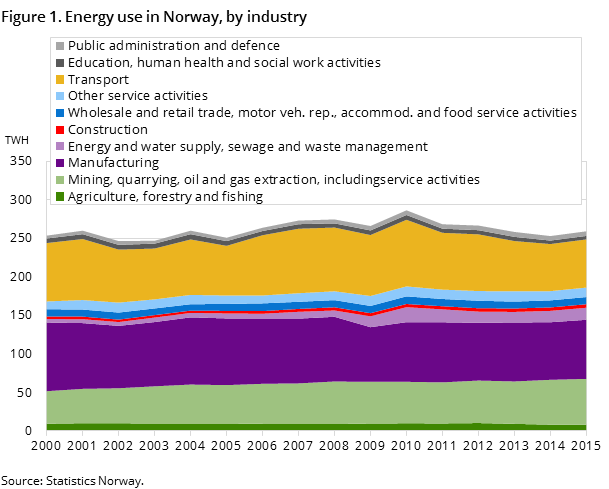
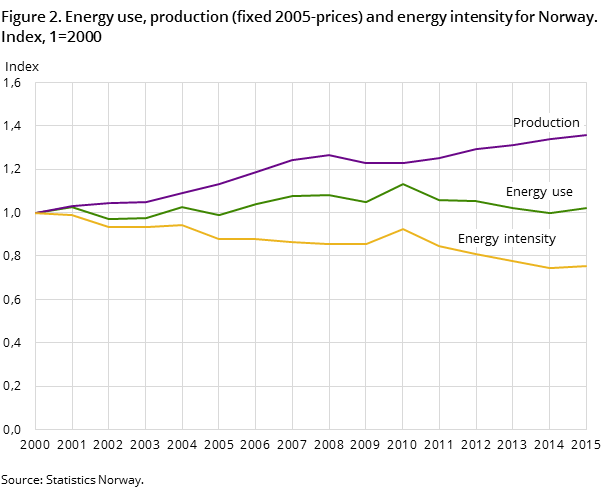
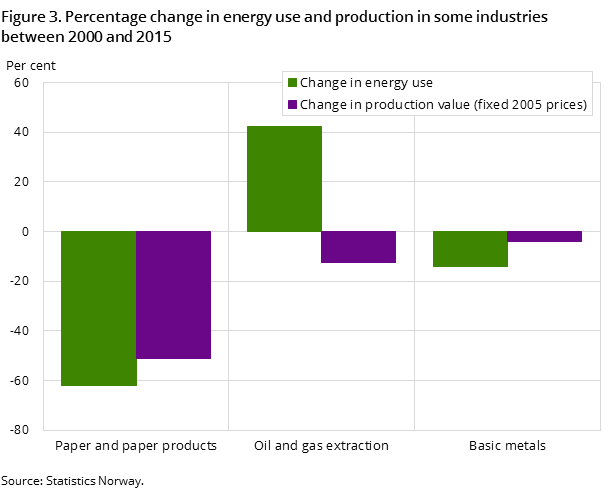
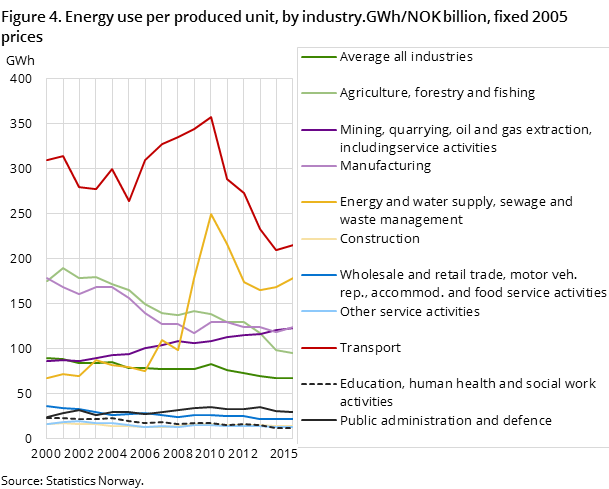
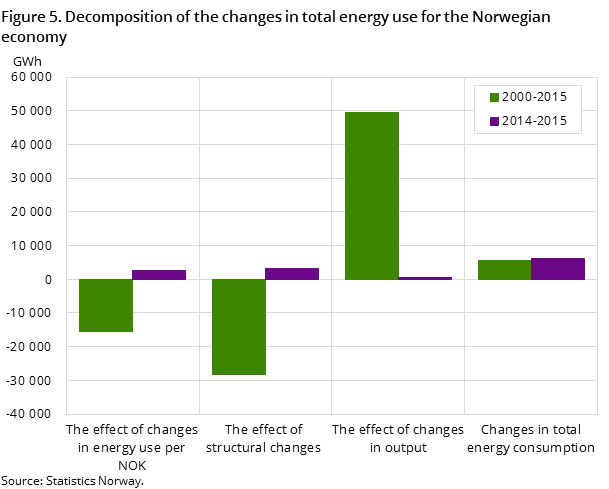
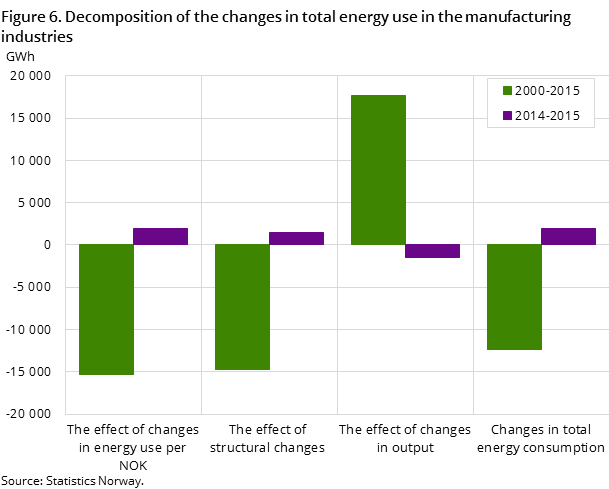
According to the energy account, total energy use in Norwegian companies was 259 TWh in 2015; an increase of 2.4 per cent from the previous year. This does not include energy products used for non-energy purposes (used as raw materials in industry) or for conversion in refineries. In addition, households used 63 TWh, which is an increase of about 1 per cent from the previous year.
Energy use is affected by several different conditions
The level of energy consumption is influenced by several factors. Increased production of goods and services contribute to higher energy consumption, while the technological development of more energy efficient products and a focus on energy efficiency could contribute to lower energy consumption. The composition of businesses in the economy also has a large bearing on the development of energy consumption for the economy as a whole, where structural changes such as the growth in energy-intensive industries contribute to increased energy consumption.
Assessing the energy intensity over time gives an indication of whether the production has been more or less energy intensive.
Increased energy intensity in the Norwegian economy in 2015
Looking at the energy consumption in relation to production of goods and services in Norwegian enterprises provides a measure of energy intensity. In 2015, Norwegian businesses used a total of 68 GWh per billion production measured in constant prices. This is 1.2 per cent higher than the previous year, but 24 per cent lower than in 2000. However, there is considerable variation between the individual sectors of the Norwegian economy.
Increased energy consumption and reduced production in industry in 2015
While energy consumption has decreased since the millennium, production in industry has increased. This has resulted in a decrease in energy intensity of 30 per cent from 2000 to 2015. For 2015, the trend was different. Energy use in manufacturing was 77 TWh in 2015; an increase of 2.5 per cent from 2014. In the same period there was a decrease in the total production of the industry, making the overall industrial production more energy intensive. Energy intensity averaged 124 GWh per billion NOK in 2015 for the industry; an increase of more than 4 per cent from the year before.
The reduction in energy consumption has been particularly high in energy-intensive industries such as metals and paper production since the millennium. Metal industries used 31 TWh in 2015, which is 14 per cent lower than in 2000. Industries within production of paper and paper products used 4.4 TWh in 2015, which is a decline of over 60 per cent from 2000. Closures of paper mills and lower production are a large part of the explanation for reduced energy use for the paper industry. In addition, less energy is now used per unit produced. Energy intensity in the production of paper and paper products has decreased by 24 per cent during this period.
Significantly increased energy use in oil and gas
Energy use in oil and gas production has increased by almost 3 per cent from 2014 and 40 per cent since 2000 to 58 TWh in 2015. During the same period, the reduction in production has led to an increase of 63 per cent in the energy intensity. From 2014 to 2015, however, energy intensity decreased by nearly 1 per cent.
Reduced energy intensity for primary industries and land transport
Since 2000, energy intensity has decreased by 46 per cent for agriculture, forestry and fishing, and just over 30 per cent for transport industries. Energy intensity also showed a decline in 2015 for primary industries. For transport industries overall, the energy intensity increased from 2014 to 2015, although for land transport there was a reduction.
Increased energy consumption for households
Energy consumption in households increased by about 1 per cent from the previous year. Compared with 2000, there has been an increase of about 4 per cent, which is significantly lower than the growth in household consumption and population growth during this period. The increase in energy consumption in 2015 is partly due to colder weather in 2015 than in 2014, which was a record hot year.
What determines energy consumption in the Norwegian economy?Open and readClose
The change in energy use in the Norwegian economy is due to several factors. Increased economic activity is the main cause of higher energy use in most industries, but changes in industry structure and how efficiently energy is used also affect the extent of energy consumption. Statistics Norway has analysed the reasons behind the development in total energy consumption for the Norwegian economy as a whole and for detailed industries based on the change in three factors:
- How efficiently industry groups utilise the energy in production (energy efficiency)
- The industry groups’ share of total production value (industry structure)
- Total production value from the industries (activity)
The development in the manufacturing industries from 2012 to 2013 is described in the Norwegian article on more effective energy consumption in 2013 (Mer effektiv energiutnyttelse i 2013), while developments for the period 2003-2012 are described in the Norwegian article on increased manufacturing production with less energy (Økt industriproduksjon med mindre energi).
The results of these analyses for the different time periods are now available in Statbank (see Statbank Table 10908).
Deterioration in the utilisation of energy in the Norwegian economy in 2015Open and readClose
Decomposition analyses can be used to better understand the reasons for the changes in energy consumption. Decomposition analyses have now been undertaken for the economy in Norway as a whole as well as for different industry groups.
The energy consumption in the Norwegian economy grew by 2.4 per cent in 2015, while the production activity (measured in fixed prices) grew by 1.2 per cent. In isolation, the increased production in Norway would have resulted in a 0.2 per cent increase in energy consumption in 2015, but the relative shift of production between the different industries in Norwegian industry (restructuring) has collectively pulled energy use up by a total of 1.2 per cent. As opposed to previous years, the utilisation of energy in the Norwegian economy deteriorated in 2015. The analysis shows that, in isolation, the ineffective energy utilisation in 2015 would have caused a 1 per cent increase in the energy consumption.
The situation in 2015 is somewhat different from previous years, since the restructuring and the energy utilisation pulled energy consumption up and not down. For the period 2000–2015, production in the Norwegian economy increased by 36 per cent and energy consumption increased by 2.2 per cent.
From 2000–2015, the increased production in the Norwegian economy would, in isolation, have resulted in an increase in energy consumption of 19 per cent. The restructuring of Norwegian industries and improved energy utilisation would, in isolation, have resulted in a reduced energy consumption from 2000 to 2015 of 11 and 6 per cent each.
The decomposition analysis also allows for analyses of different industry groups. For the years 2000–2015, output (measured in fixed prices) in Norwegian manufacturing increased by 24 per cent, while energy consumption in the same period fell by 14 per cent. The main reason for the decline in energy consumption has been more effective utilisation of energy, in addition to changes in industry restructuring resulting from the energy-intensive manufacturing industries, with the largest energy consumption having a smaller share of the total industrial output in 2015 than in 2000. The situation in 2015 is also somewhat different from previous years for manufacturing industries, since the restructuring and energy utilisation pulled energy consumption up and not down.
The statistics is now published as Production and consumption of energy, energy balance and energy account.
Contact
-
Statistics Norway's Information Centre
E-mail: informasjon@ssb.no
tel.: (+47) 21 09 46 42
